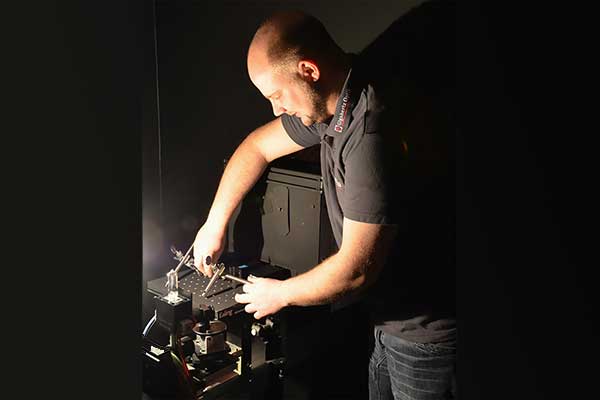
Traceable Calibration of Spectroradiometers for Measuring Solar Radiation
The measurement quantity for determining the intensity of optical radiation incident on a reference surface is irradiance, measured in terms of W/m². Spectroradiometers used for atmospheric research must be calibrated for their spectral irradiance sensitivity. Standard lamps are used as the reference for calibrating spectroradiometers. Their spectral irradiance is certified by a calibration traceable to a national metrology institute.
Gigahertz-Optik GmbH has been producing the standard lamp model BN-9101 for spectral irradiance since 1991.
The design of this 1000 W quartz halogen lamp was made in collaboration with the Physikalisch-Technische Bundesanstalt, PTB. The FEL lamps manufactured by both General Electric and Osram Sylvania are used. All lamps are examined for spectral anomalies before being calibrated.

Graph 1: For lamp A, an absorption in the wavelength range around 280 nm can be seen. It amounts to a maximum of about 5%. Thus, a possible spline interpolation of the data leads to undesired deviations. Such lamps are selected and are not approved as a calibration lamp.
Some noteworthy features of the construction are the thermally stable cementing of the lamp in its holder and the precise setting of the filament to the crosshairs of the accompanying alignment tool.
Since the accreditation of its calibration laboratory for the spectral irradiance in 1993, Gigahertz-Optik GmbH has supplied accredited calibrations, initially certified by DKD-K-10601 and since 2010, by DAkkS certificate D-K-15047-01-00. As part of the maintenance of the calibration standards used within the DAkkS certified calibration laboratory, its standard lamps are regularly calibrated by PTB Braunschweig and their measured data are compared with those of Gigahertz-Optik GmbH. These comparisons ensure the accuracy of traceability.

Graph 2: The determined deviations of the spectral irradiance are within the measurement uncertainty of the PTB.
The standard lamp BN-9101 is used in many single applications, but also serves in round robin comparisons as a transfer standard to compare the institutions involved. References [1] to [6] below cite the important role of the BN-9101 in a selection of solar radiation measurement scenarios.
References
[5] Photolysis frequency measurement techniques: results of a comparison within the ACCENT project
[6] Aalto University - Instruction Manual of Operating Standard Lamps